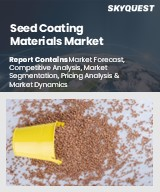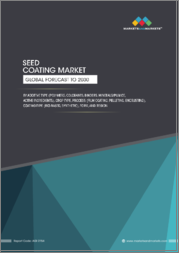
|
시장보고서
상품코드
1796452
종자 코팅재 시장 규모, 점유율, 성장 분석 : 유형별, 작물 유형별, 첨가제별, 지역별 - 산업 예측(2025-2032년)Seed Coating Materials Market Size, Share, and Growth Analysis, By Type (Polymer Coatings, Powder-based Coatings), By Crop Type (Cereals and Grains, Oilseeds and Pulses), By Additive, By Region - Industry Forecast 2025-2032 |
||||||
세계의 종자 코팅재 시장 규모는 2023년에 18억 달러로 평가되며, 2024년 19억 1,000만 달러에서 2032년에는 30억 2,000만 달러로 성장하며, 예측 기간(2025-2032년)의 CAGR은 5.9%로 성장할 전망입니다.
세계 종자 코팅재 시장은 농업의 수확량 증가와 지속가능성에 대한 요구로 인해 크게 성장하고 있습니다. 식량안보와 제한된 경작지에 대한 우려로 인해 농가는 발아율을 높이고 균일한 식물 정착을 촉진하며 병해충으로부터 보호할 수 있는 종자 처리 프로토콜을 채택하는 경향이 증가하고 있습니다. 폴리머, 착색제, 결합제, 활성 화학물질을 함유한 종자 코팅제는 미량영양소, 비료, 살충제를 종자에 직접 표적화하여 전달하기 쉽고, 폐기물과 환경에 미치는 영향을 최소화합니다. 유기농 기준에 부합하는 미생물 접종제 및 생물 자극제를 특징으로 하는 생물학적 종자 코팅 증가 추세는 시장 확대를 더욱 촉진하고 있습니다. 신흥 경제국에서의 상업화 발전은 지역별로 특화된 종자 코팅 솔루션에 대한 수요를 창출하고 효율적인 현대 농업의 역할을 강화하고 있습니다.
목차
서론
- 조사의 목적
- 조사 범위
- 정의
조사 방법
- 정보 조달
- 2차와 1차 데이터 방법
- 시장 규모 예측
- 시장의 전제조건과 제한
개요
- 세계 시장 전망
- 공급과 수요 동향 분석
- 부문별 기회 분석
시장 역학과 전망
- 시장 개요
- 시장 규모
- 시장 역학
- 촉진요인과 기회
- 억제요인과 과제
- Porter의 산업 분석
주요 시장 인사이트
- 주요 성공 요인
- 경쟁의 정도
- 주요 투자 기회
- 시장 에코시스템
- 시장의 매력 지수(2024년)
- PESTEL 분석
- 거시경제 지표
- 밸류체인 분석
- 가격 분석
- 사례 연구
- 고객 구매 행동 분석
종자 코팅재 시장 규모 : 유형별 & CAGR(2025-2032년)
- 시장 개요
- 폴리머 코팅
- 분체 코팅
- 액체 코팅
종자 코팅재 시장 규모 : 작물 유형별 & CAGR(2025-2032년)
- 시장 개요
- 곡물
- 지방 종자와 두류
- 과일과 채소
- 기타 작물
종자 코팅재 시장 규모 : 첨가제별 & CAGR(2025-2032년)
- 시장 개요
- 바인더
- 착색제
- 비료
- 농약
- 기타 첨가제
종자 코팅재 시장 규모 & CAGR(2025-2032년)
- 북미
- 미국
- 캐나다
- 유럽
- 독일
- 스페인
- 프랑스
- 영국
- 이탈리아
- 기타 유럽
- 아시아태평양
- 중국
- 인도
- 일본
- 한국
- 기타 아시아태평양
- 라틴아메리카
- 브라질
- 기타 라틴아메리카
- 중동 및 아프리카
- GCC 국가
- 남아프리카공화국
- 기타 중동 및 아프리카
경쟁 정보
- 상위 5사의 비교
- 주요 기업의 시장 포지셔닝(2024년)
- 주요 시장 기업이 채택한 전략
- 최근 시장 동향
- 기업의 시장 점유율 분석(2024년)
- 주요 기업의 기업 개요
- 기업의 상세
- 제품 포트폴리오 분석
- 기업의 부문별 점유율 분석
- 매출의 전년대비 비교(2022-2024년)
주요 기업 개요
- BASF SE(Germany)
- Bayer AG(Germany)
- Syngenta Group(Switzerland)
- Croda International Plc(United Kingdom)
- Clariant AG(Switzerland)
- BrettYoung Seeds Ltd.(Canada)
- Incotec Group BV(Netherlands)
- Micromix Plant Health Ltd.(United Kingdom)
- Germains Seed Technology(United States)
- Precision Laboratories, LLC(United States)
- Seed-X Technologies(Israel)
- Sensient Technologies Corporation(United States)
- Ciranda, Inc.(United States)
- Chromatech Incorporated(United States)
- Green Technologies LLC(United States)
결론과 제안
KSA 25.08.29Global Seed Coating Materials Market size was valued at USD 1.8 billion in 2023 and is poised to grow from USD 1.91 billion in 2024 to USD 3.02 billion by 2032, growing at a CAGR of 5.9% during the forecast period (2025-2032).
The global seed coating materials market is witnessing significant growth driven by the need for improved yield and sustainability in agriculture. With concerns over food security and limited arable land, farmers are increasingly adopting seed treatment protocols that enhance germination rates, promote uniform plant establishment, and offer protection against pests and diseases. Seed coating materials, which include polymers, colorants, binders, and active chemicals, facilitate the targeted delivery of micronutrients, fertilizers, and pesticides directly to seeds, thereby minimizing waste and environmental impact. The rising trend of biological seed coatings, featuring microbial inoculants and bio-stimulants compliant with organic standards, is further bolstering market expansion. Increased commercialization in emerging economies is also creating demand for region-specific seed coating solutions, reinforcing their role in efficient modern agriculture.
Top-down and bottom-up approaches were used to estimate and validate the size of the Global Seed Coating Materials market and to estimate the size of various other dependent submarkets. The research methodology used to estimate the market size includes the following details: The key players in the market were identified through secondary research, and their market shares in the respective regions were determined through primary and secondary research. This entire procedure includes the study of the annual and financial reports of the top market players and extensive interviews for key insights from industry leaders such as CEOs, VPs, directors, and marketing executives. All percentage shares split, and breakdowns were determined using secondary sources and verified through Primary sources. All possible parameters that affect the markets covered in this research study have been accounted for, viewed in extensive detail, verified through primary research, and analyzed to get the final quantitative and qualitative data.
Global Seed Coating Materials Market Segments Analysis
Global Seed Coating Materials Market is segmented by Type, Crop Type, Additive and region. Based on Type, the market is segmented into Polymer Coatings, Powder-based Coatings and Liquid-based Coatings. Based on Crop Type, the market is segmented into Cereals and Grains, Oilseeds and Pulses, Fruits and Vegetables and Other Crops. Based on Additive, the market is segmented into Binders, Colorants, Fertilizers, Pesticides and Other Additives. Based on region, the market is segmented into North America, Europe, Asia Pacific, Latin America and Middle East & Africa.
Driver of the Global Seed Coating Materials Market
The rising global demand for food, coupled with the escalating agricultural challenges posed by various climate-related stresses such as drought, salinity, and extreme weather events, is driving the need for innovative seed coating materials. This growing market stimulates seed manufacturers and agribusinesses to create advanced seed coatings and treatments aimed at enhancing crop resilience. As a result, these developments not only improve crop durability but also significantly contribute to the expansion of the global seed coating materials market. The focus on sustainable agricultural practices further propels the need for effective seed coatings that can withstand adverse environmental conditions.
Restraints in the Global Seed Coating Materials Market
The Global Seed Coating Materials market faces challenges primarily due to the high costs associated with acquiring coatings, equipment, and application. These elevated expenses can deter small and marginal farmers from adopting these beneficial materials, as they often operate within budget constraints. Additionally, the sensitivity of certain markets to pricing and obstacles related to distribution and accessibility further restrict consumer engagement. As a result, these factors hinder market penetration and scalability, posing a challenge for growth in an evolving agricultural landscape where innovative solutions are increasingly crucial for enhancing productivity and sustainability.
Market Trends of the Global Seed Coating Materials Market
The Global Seed Coating Materials market is witnessing a significant shift towards the adoption of bio-based and eco-friendly coatings, driven by an increasing emphasis on sustainability. As environmental concerns gain prominence, manufacturers are innovating with natural polymers, plant-derived colorants, and bio-stimulant-infused coatings that align with sustainable farming practices. This trend not only caters to the growing demand for biodegradable and non-toxic solutions but also adheres to stringent global regulations, enhancing the appeal of eco-conscious products in agricultural sectors. This evolution reflects a broader movement towards environmentally responsible farming, positioning bio-based seed coatings as a vital component of modern agricultural strategies.
Table of Contents
Introduction
- Objectives of the Study
- Scope of the Report
- Definitions
Research Methodology
- Information Procurement
- Secondary & Primary Data Methods
- Market Size Estimation
- Market Assumptions & Limitations
Executive Summary
- Global Market Outlook
- Supply & Demand Trend Analysis
- Segmental Opportunity Analysis
Market Dynamics & Outlook
- Market Overview
- Market Size
- Market Dynamics
- Drivers & Opportunities
- Restraints & Challenges
- Porters Analysis
- Competitive rivalry
- Threat of substitute
- Bargaining power of buyers
- Threat of new entrants
- Bargaining power of suppliers
Key Market Insights
- Key Success Factors
- Degree of Competition
- Top Investment Pockets
- Market Ecosystem
- Market Attractiveness Index, 2024
- PESTEL Analysis
- Macro-Economic Indicators
- Value Chain Analysis
- Pricing Analysis
- Case Studies
- Customer Buying Behavior Analysis
Global Seed Coating Materials Market Size by Type & CAGR (2025-2032)
- Market Overview
- Polymer Coatings
- Powder-based Coatings
- Liquid-based Coatings
Global Seed Coating Materials Market Size by Crop Type & CAGR (2025-2032)
- Market Overview
- Cereals and Grains
- Oilseeds and Pulses
- Fruits and Vegetables
- Other Crops
Global Seed Coating Materials Market Size by Additive & CAGR (2025-2032)
- Market Overview
- Binders
- Colorants
- Fertilizers
- Pesticides
- Other Additives
Global Seed Coating Materials Market Size & CAGR (2025-2032)
- North America (Type, Crop Type, Additive)
- US
- Canada
- Europe (Type, Crop Type, Additive)
- Germany
- Spain
- France
- UK
- Italy
- Rest of Europe
- Asia Pacific (Type, Crop Type, Additive)
- China
- India
- Japan
- South Korea
- Rest of Asia-Pacific
- Latin America (Type, Crop Type, Additive)
- Brazil
- Rest of Latin America
- Middle East & Africa (Type, Crop Type, Additive)
- GCC Countries
- South Africa
- Rest of Middle East & Africa
Competitive Intelligence
- Top 5 Player Comparison
- Market Positioning of Key Players, 2024
- Strategies Adopted by Key Market Players
- Recent Developments in the Market
- Company Market Share Analysis, 2024
- Company Profiles of All Key Players
- Company Details
- Product Portfolio Analysis
- Company's Segmental Share Analysis
- Revenue Y-O-Y Comparison (2022-2024)
Key Company Profiles
- BASF SE (Germany)
- Company Overview
- Business Segment Overview
- Financial Updates
- Key Developments
- Bayer AG (Germany)
- Company Overview
- Business Segment Overview
- Financial Updates
- Key Developments
- Syngenta Group (Switzerland)
- Company Overview
- Business Segment Overview
- Financial Updates
- Key Developments
- Croda International Plc (United Kingdom)
- Company Overview
- Business Segment Overview
- Financial Updates
- Key Developments
- Clariant AG (Switzerland)
- Company Overview
- Business Segment Overview
- Financial Updates
- Key Developments
- BrettYoung Seeds Ltd. (Canada)
- Company Overview
- Business Segment Overview
- Financial Updates
- Key Developments
- Incotec Group BV (Netherlands)
- Company Overview
- Business Segment Overview
- Financial Updates
- Key Developments
- Micromix Plant Health Ltd. (United Kingdom)
- Company Overview
- Business Segment Overview
- Financial Updates
- Key Developments
- Germains Seed Technology (United States)
- Company Overview
- Business Segment Overview
- Financial Updates
- Key Developments
- Precision Laboratories, LLC (United States)
- Company Overview
- Business Segment Overview
- Financial Updates
- Key Developments
- Seed-X Technologies (Israel)
- Company Overview
- Business Segment Overview
- Financial Updates
- Key Developments
- Sensient Technologies Corporation (United States)
- Company Overview
- Business Segment Overview
- Financial Updates
- Key Developments
- Ciranda, Inc. (United States)
- Company Overview
- Business Segment Overview
- Financial Updates
- Key Developments
- Chromatech Incorporated (United States)
- Company Overview
- Business Segment Overview
- Financial Updates
- Key Developments
- Green Technologies LLC (United States)
- Company Overview
- Business Segment Overview
- Financial Updates
- Key Developments
















